Modern Delhi, popularly known as Lutyens' Delhi, bears a striking contrast to Old Delhi with respect to architecture, building materials and layout. However, Modern Delhi itself dates back to over a century when the British shifted their capital from Calcutta to Delhi. New Delhi, as it is known today, designed by Lutyens, has wide-open lanes, avenues and buildings that are worth traveling across the globe for.
Besides the usual tourist attractions of Modern Delhi - India Gate, Rashtrapati Bhavan,Parliament House, North and South Block - which are stunning examples of British architecture, you can also visit the various museums, temples and memorials that provide a comprehensive and entertaining insight into the lives of Delhites.
National Museum, at par with any international museum, is an important place to visit in modern Delhi. Here, you can catch glimpses of the rich historical past of India, from the ancient period to the medieval ages.
National Rail Museum documents the more than 150-year-old history of Indian railways, including the first steam engine that ran from Thane, Mumbai in 1853 that marked the beginning of Indian Railways.
The Culture of Delhi
Delhi is the traditional and present day capital of India. Delhi stands in a triangle formed by the river Yamuna in the east and spurs from the Aravali range in the west and south.
Delhi is not only the largest commercial centre in Northern India, but also the largest centre of small industries. The IT sector, handloom, fashion, textile and electronic industry contribute a lot to Delhi's economy.
Delhi is bounded by four states namely Haryana, Rajasthan, Uttar Pradesh and Punjab that have a strong influence on the lifestyle of Delhi. Delhi is a cosmopolitan city where people are open to embracing new ideas and life style. People from all parts of the country live here. Alll major festival of Inida are celebrated and the Unity in Diversity is evident in social and cultural gatherings. Be it Holi, Diwali, Id, Guru Purab, Buddha Purnima orChristmas, you will find the same vigor and bliss among people from different communities.
Best Time to Visit
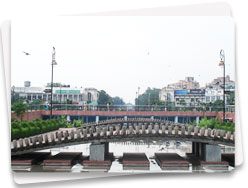
The best time to visit Delhi is from October to March when the weather is at its best. During this period flowers are at their blooming best, the weather is pleasent and enjoyable to experience Incredible Delhi.
How to Reach
By Air
Delhi is well connected with domestic and international flights, to all the major cities within and outside India. Almost all the major airlines have their flights operating from Indira Gandhi International Airport at New Delhi. Domestic Airport connects Delhi to the major cities in India.
By Train
The railway network connects Delhi to the all major and, nearly, all the minor destinations in India. The three important railway stations of Delhi are New Delhi Railway Station, Old Delhi Railway Station and Hazrat Nizamuddin Railway Station.
By Road
Delhi is well connected, by a network of roads and national highways, with all the major cities in India. The three major bus stands in Delhi are Inter State Bus Terminus (ISBT) at Kashmiri Gate, Sarai Kale-Khan Bus Terminus and Anand Vihar Bus Terminus. Both the government and private transport providers provide frequent bus services. One can also get government as well as private taxis here.
ISD Code of India: +91
STD Code of Delhi: 011
- Police - 100 / 1090
- Fire - 101
- Ambulance - 102
- Accident & Trauma Service - 1099
- Tourist City Information Service - 1280
- Child Helpline - 1098
- Women's Helpline - 1091
- Domestic Terminal
http://www.newdelhiairport.in
Delhi Airport - +91-124-3376000 - International Terminal
Exchange +91-11-3376000
Air India 2565 2050Delhi Metro Enquiries
- www.delhimetrorail.com
24 Hours DMRC Helpline No.:
+91-11-128128
For calling from mobile phones
Please dial 011 -128128 - Delhi - 011
- Noida - 0120
- Gurgaon - 0124
- Faridabad - 0129
- Ghaziabad - 0120
- Bahadurgarh - 01276
- Inter-State Enquiry at Kashmiri Gate
Terminus - 91-11-22960290; 91-11- 22968836 - Inter-State Enquiry at Sarai Kale Khan
Terminus - 91-11-24698343; 91-11-24638092 - Inter-State Enquiry at Anand Vihar
Terminus - 91-11-22148097 - UP Roadways - 91-11-22968709
- Haryana Roadways - 91-11-22961262
- Punjab Roadways - 91-11-22967892
- Himachal Roadways - 91-11-22966725
- Rajasthan Roadways - 91-11-22919537
- J&K Roadways - 91-11-23324511
- Directory Enquiry - 197
- Telephone Complaint - 198
- Internet Customer Care - 1504
- Change Number Hindi/Eng - 1951/1952
Airport Enquiries
STD Code
Bus Services
Telephone Services
- Anand Vihar, ISBT 22152431
- Sarai Kale Khan 24358343/ 8092
- Kashmere Gate 23865181/ 23868836
Ext. : 217 - DTC Local Enquiry 23317600
- DTC Website : http://dtc.nic.in
- U.P. Roadways 22149089
Railway Enquiries
- http://www.indianrail.gov.in
General Enquiries - 139Air India
- General Enquiry - 25652050 & 18001801407
- AIIMS - 91-11-26588700
- Indian Red Cross Society 24618073, 24618915
- New Delhi - 91-11-23361231 Extn. 3705
- Delhi - 91-11-22512201 Extn. 577
- North - 91-11-23962281
- ITDC - 91-11-23719039
- Delhi Tourist City Information Service - 1280
- Transport Arrangements - 91-11-24674153, 26884312
- Tours Department - 91-11-23363607, 23365358
- Delhi (DTDC) - 91-11-23363607; 91-11-23365358
- Haryana - 91-11-23324910; 91-11-23324911
- Himachal Pradesh - 91-11-23325320;
91-11-23324764 - Punjab - 91-11-23343055
- Rajasthan - 91-11-23383837; 91-11-23389525
- Uttar Pradesh - 91-11-23711296; 91-11-23322251
- Uttranchal - 91-11-23350481
Roadways Enquiries
Blood Banks
Bomb Disposal Squads
Tourist Enquiry
Tourism Departments:
Medical Emergencies
Delhi has possibly the country's best medical infrastructure. This ranges from specialised state-of-the-art medical facilities to traditional healing hospitals.
All India Institute of Medical Sciences
Ph: 011-26588500/ 26588700VIMHANS (Mental Health & Neuroscience)
Ph: 26310510 - 20National Heart Institute
Ph: 011-26414156
26414157 / 26414075National Chest Institute
Ph: 011- 26864012
26964044 / 26960436Escorts Heart Institute and Research Centre
Ph: 011-26825000 - 3Cancer Detection Centre
Ph: 011-23716941Guru Nanak Eye Centre
Ph: 011-23233080 / 23236745Apollo
Ph: 011-26925858
26825555 / 26925801 / 1066Indian Spinal Injuries Centre
Ph: 011-26137603
26894884 / 26896642Indian Spinal Injuries Centre (Cardiac).
Ph: 011-26139660Lok Nayak Jai Prakash
Ph: 011-23233400
23231621 / 23232400 / 23230733
Ram Manohar Lohia
Ph: 011-23365525 / 23404040Orthonova
Ph: 011-51657554-8Hindu Rao
Ph: 011-23932307/ 23932314G B Pant
Ph: 011-23234242 / 23233001Sri Ganga Ram
Ph: 011-25781837
25735205 / 25721529Batra
Ph: 011-29958747
29957481/ 29957585-6G. M. Modi
Ph: 011-26852112 / 26852113Sita Ram Bhartia Institute
Ph: 011-52111111
26867435-8 / 26867279 / 26867933Max Healthcare
Ph: 011-26499870 / 27158844Fortis
Ph: 011-42776222
- Eight Cities of Delhi
SUCCESSIVE CITIES OF DELHI
Three things make a city - Daria, Badal, Badshah.This is to say, a river, rain- bringing clouds, or an emperor(who can enforce his wishes)Native proverb"Here we stand in Delhi city, symbol of old India and the new. It is not the narrow lanes and houses of old Delhi nor the wide spaces and rather pretentious buildings of New Delhi that count, but the spirit of this ancient city. Delhi has been an epitome of India's history with its succession of glory and disaster and with its great capacity to absorb many cultures and yet remain itself. It is a gem with many facets, some bright and some darkened by age, presenting the course of 'India's life and thought during the ages.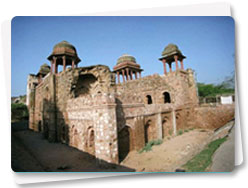
We face the good and the bad of India in Delhi city which has been the grave of many empires and the nursery of a republic. What a tremendous story of hers! Here the tradition of millennia of our history surrounds us at every step, and the procession of innumerable generations passes by before our eyes"Prime Minister Jawaharlal NehruFrom Convocation Address of Delhi UniversityDecember, 1958
Delhi has a long history which despite occasional dislocation, has shown a remarkable continuity and has the unique distinction of having been India's capital longer than any other city. Ancient legend has that "he who rules Delhi, rules India". It has survived all the vicissitudes of time and fortune. Though it has frequently changed its site, its character and its name, it has throughout a continuous thread of existence it has seen the rise and fall of many civilizations. From Indraprastha of Mahabharat to the present New Delhi, it has grown into a mega metropolis. From the Dilli of Raja Dillu to the New Delhi, it has always commanded power.
The earliest reference to a settlement at Delhi is found in Mahabharata. King Dhratarshta of Hastinapur have the tracts around Delhi to Pandavas to set-up their Kingdom. This part of Delhi was known as Khandavaprastha. Yudhisthir, the Pandava prince, cleared the forest known as Khandavavan and established the city, Indraprastha, in Delhi. Indeed it was a formidable city so grand that it made kauravas the enemies of pandavas. From that period Delhi witnessed the rise and fall of many dynasties and Empires. The location of the city attracted Indian rulers of all kinds from ancient times because of its strategic and commercial value.
It would be easy to argue that the cities of Delhi were in reality less or more than seven. But the accepted number is seven (excluding New Delhi) and these are cities whose remains are extant. Historians speak of the "Seven Cities of Delhi" but, between 1100 A.D. and 1947 A.D., there have actually been eight of them:- The oldest city near the site of the Qutab Minar
- Siri
- Tughlqabad
- Jahanpanah
- Firozobad
- The city around Purana Qila
- Shahjahanabad
- New Delhi
Each of the these cities grew round the palace - fortress of a particular dynasty and every dynasty wished to have a new headquarters for consideration of prestige. Even the Kings of the same dynasty had this ambitions, and realized it if they had the means to do so. With each successive reign, some distinctive architectural features was added or some change in urban morphology occurred. Often some important new buildings would, rise, something monumental - whether a mosque or a tomb, a palace, a fortress or a victory-tower.
The story of Delhi as the Capital of India began with the Muslim conquest of Northern India at the end of twelfth century. Since then, with some interludes, it has been the seat of every central political authority. - Lal Kot or Quila Rai Pithora
 Although Delhi had been a thriving city for several centuries, the first city' of the dating to 11th century gets its recognition due to the availability of recorded historical facts. Qila Rai Pithora was created by Prithviraj Chauhan, also known as Rai Pithora, the popular hero of the stories of Hindu resistance against Muslim invaders. Prithviraj’s ancestors captured Delhi from the Tomar Rajputs who have been credited with founding Delhi. Anangpal, a Tomer ruler possibly created the first known regular defense- work in Delhi called Lal Kot- which Prithviraj took over and extended for his city Qila Rai Pithora. The ruins of the fort ramparts are still partly visible in the area around Qutab Minar. During the ear of Tomar and Chauhans magnificent temples were built in Delhi. It is believed that twenty seven Hindu temples complex existed at the site of Quwwat-ul-Islam Mosque and Qutub Minar. The Iron Pillar standing at Mehrauli in utter defiance of rust and ravages of time tells the glory and prosperity of the Rajput dynasty. The Iron Pillar however was not originally in the Qutub Complex and it would appear that it was transported to its current location, perhaps by the Tomer ruler, Anangpal-II from Udayagiri in Central India. The remains of Rai Pithora can still be seen in the present Saket, Mehrauli, Kishangarh and Vasant Kunj area.Mehrauli
Although Delhi had been a thriving city for several centuries, the first city' of the dating to 11th century gets its recognition due to the availability of recorded historical facts. Qila Rai Pithora was created by Prithviraj Chauhan, also known as Rai Pithora, the popular hero of the stories of Hindu resistance against Muslim invaders. Prithviraj’s ancestors captured Delhi from the Tomar Rajputs who have been credited with founding Delhi. Anangpal, a Tomer ruler possibly created the first known regular defense- work in Delhi called Lal Kot- which Prithviraj took over and extended for his city Qila Rai Pithora. The ruins of the fort ramparts are still partly visible in the area around Qutab Minar. During the ear of Tomar and Chauhans magnificent temples were built in Delhi. It is believed that twenty seven Hindu temples complex existed at the site of Quwwat-ul-Islam Mosque and Qutub Minar. The Iron Pillar standing at Mehrauli in utter defiance of rust and ravages of time tells the glory and prosperity of the Rajput dynasty. The Iron Pillar however was not originally in the Qutub Complex and it would appear that it was transported to its current location, perhaps by the Tomer ruler, Anangpal-II from Udayagiri in Central India. The remains of Rai Pithora can still be seen in the present Saket, Mehrauli, Kishangarh and Vasant Kunj area.Mehrauli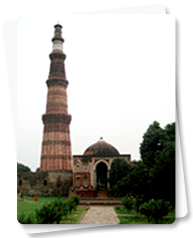 After a dramatic defeat of Prithviraj Chauhan, the rule of the Hindu dynasty over Delhi came to an end in 1191 A.D. It was captured by Qutabuddin Aibak, the slave commander of Mohammad Ghori, after numerous defeats. This was the beginning of Delhi Sultanate and for next 600 years Islamic dymasties prevailed. The seat of the rule of invaders had been Mehrauli, which was the living capital of Hindu predecessors.
After a dramatic defeat of Prithviraj Chauhan, the rule of the Hindu dynasty over Delhi came to an end in 1191 A.D. It was captured by Qutabuddin Aibak, the slave commander of Mohammad Ghori, after numerous defeats. This was the beginning of Delhi Sultanate and for next 600 years Islamic dymasties prevailed. The seat of the rule of invaders had been Mehrauli, which was the living capital of Hindu predecessors.
After the death of Mohammad Ghori in 1206 Qutabuddin Aibak became the first Sultan of Delhi and Quwwat-ul-Islam was laid on the site of Hindu fort as Delhi's first mosque. The construction of Qutab Minar (now World Heritage monument) was started by Aibak and continued by Iltutmish and his successor. It became the most dominating symbol and a landmark of Delhi. However, legend says that the Rajput King Prithvi Raj raised his minarate for astronomical observations. His daughter could see the holy Yamuna from its top. On the outskirts of Mehrauli a water reservoir known as Shamsi Talab and Jahaz Mahal were built over a faint footprint, said to be that of the Prophet. Jahaz Mahal, built in 1230 A.D is a beautiful structure of grey and red stone. It is the venue of annual festival of Phool Walon Ki Sair. The citadel wall, observation towers, numerous tombs and other lofty structures of Mehrauli dominate its hilly landscape. These reflect that Mehrauli during the Sultanate era was one of the most magnificent and thriving capital city. It had often been referred as Old Delhi till the construction of New Delhi, after which Shahjahanabad was termed as the Old Delhi.Siri The Slave rulers were succeeded by the Khiljis on the political scene of Delhi by the end of 13th Century. The Khiljis were, in fact, a Turkish tribe and settled in Afghanistan, where they acquired Afghani manners and customs. Among the six rulers of Khilji dynasty, Alauddin Khilji laid the foundation of his capital Siri in 1303 A.D. He also commissioned a minar (Victory Tower) exceeding the Qutab Minar but the same could not be completed. He also excavated a reservoir known as Hauz Khaz to meet the requirement of Siri township. He also constructed semi circular gateway with horseshoe shaped arch with lotus metifs. This gateway is popularly known as Alai Darwaja and has been considered, in the history of Islamic Architecture a representative of a true arch.Tughlakabad
The Slave rulers were succeeded by the Khiljis on the political scene of Delhi by the end of 13th Century. The Khiljis were, in fact, a Turkish tribe and settled in Afghanistan, where they acquired Afghani manners and customs. Among the six rulers of Khilji dynasty, Alauddin Khilji laid the foundation of his capital Siri in 1303 A.D. He also commissioned a minar (Victory Tower) exceeding the Qutab Minar but the same could not be completed. He also excavated a reservoir known as Hauz Khaz to meet the requirement of Siri township. He also constructed semi circular gateway with horseshoe shaped arch with lotus metifs. This gateway is popularly known as Alai Darwaja and has been considered, in the history of Islamic Architecture a representative of a true arch.Tughlakabad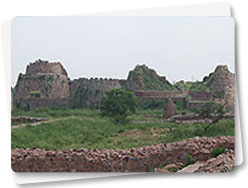 In 1320, Khilji rule was usurped by Khusro Shah in a bloody coup. Owing to the resistance of the military governor of Multan same year Ghyasuddin Tughlukshah I became the Sultan of Delhi. Tughlaks established their own township, popularly known Tughlakabad. Tughlakabad is one of the formidable reminders of Delhi's embattled past and the terror and valour of that era. Ghyasuddin came to power by beheading Khurso Khan, who had also snatched power in a bloody coup. Ghyasuddin Tughluk in order to counter attach the invading Mongols raised pyramids of enemies' heads and used the elephants to crush the captives to death. Mohammad Bin Tughlak after ruling for seven years shifted the capital to Daulatbad, Devgiri, in Aurgangabad District of Deccan. Daulatabad had water scarcity and the people suffered severely. After he realized his mistake, he shifted the capital again to Delhi in 1334. To reduce the suffering of his subjects, he built a new township and named it Jahanpanah which was located between Mehrauli and Siri. Jahanpanah which means "World's Asylum", was altogether a new city, different from Tughlakabad. He did not return to the abandoned Tughlakabad most likely because he was convinced that it was a cursed city. Legend asserts that the Fort was deserted because of the curse of Saint Sheikh Nizamuddin Auliya, whom Ghyasuddin did not allow to make a Baoli. He prophessed that the city would be inhabited either by the Gujars or would be abandoned. Ghyasuddin died in an accident. Several buildings were constructed during Tughlak's period. Tughlaks developed their own style of architecture. The representative examples of which are Tughlakabad Fort, Bari Manzil, or Bijai Mandal between Kalu Sarai and Begampur village Khirkee Mosque, Chirag-i-Dilli's Dargah situated on Malviya Nagar-Kalkaji Road at village Chirag.Firozabad
In 1320, Khilji rule was usurped by Khusro Shah in a bloody coup. Owing to the resistance of the military governor of Multan same year Ghyasuddin Tughlukshah I became the Sultan of Delhi. Tughlaks established their own township, popularly known Tughlakabad. Tughlakabad is one of the formidable reminders of Delhi's embattled past and the terror and valour of that era. Ghyasuddin came to power by beheading Khurso Khan, who had also snatched power in a bloody coup. Ghyasuddin Tughluk in order to counter attach the invading Mongols raised pyramids of enemies' heads and used the elephants to crush the captives to death. Mohammad Bin Tughlak after ruling for seven years shifted the capital to Daulatbad, Devgiri, in Aurgangabad District of Deccan. Daulatabad had water scarcity and the people suffered severely. After he realized his mistake, he shifted the capital again to Delhi in 1334. To reduce the suffering of his subjects, he built a new township and named it Jahanpanah which was located between Mehrauli and Siri. Jahanpanah which means "World's Asylum", was altogether a new city, different from Tughlakabad. He did not return to the abandoned Tughlakabad most likely because he was convinced that it was a cursed city. Legend asserts that the Fort was deserted because of the curse of Saint Sheikh Nizamuddin Auliya, whom Ghyasuddin did not allow to make a Baoli. He prophessed that the city would be inhabited either by the Gujars or would be abandoned. Ghyasuddin died in an accident. Several buildings were constructed during Tughlak's period. Tughlaks developed their own style of architecture. The representative examples of which are Tughlakabad Fort, Bari Manzil, or Bijai Mandal between Kalu Sarai and Begampur village Khirkee Mosque, Chirag-i-Dilli's Dargah situated on Malviya Nagar-Kalkaji Road at village Chirag.Firozabad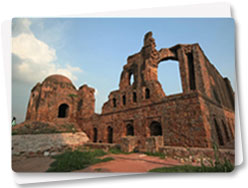 Firoze Shah Tughlaq was a more stable ruler than his father, Muhammad-bin-Tughlaq. He created the next city of Delhi- Ferozabad or Firoze Shah Kotla has been know today. He was renowned builder of medieval times, extended city from old Indraprastha to the ridge and then new capital flourished. In 1354, he brought two sandstone pillars bearing Ashokan inscriptions from Meerut and Ambala and placed one at the ridge and another at Kotla Ferozeshah. The third century B.C. Ashoka Pillar in polished sandstone with Brahmi script inscriptions is 43 meters high and weight 23 Tons.Shergarh (The Citadel of Sher Suri)
Firoze Shah Tughlaq was a more stable ruler than his father, Muhammad-bin-Tughlaq. He created the next city of Delhi- Ferozabad or Firoze Shah Kotla has been know today. He was renowned builder of medieval times, extended city from old Indraprastha to the ridge and then new capital flourished. In 1354, he brought two sandstone pillars bearing Ashokan inscriptions from Meerut and Ambala and placed one at the ridge and another at Kotla Ferozeshah. The third century B.C. Ashoka Pillar in polished sandstone with Brahmi script inscriptions is 43 meters high and weight 23 Tons.Shergarh (The Citadel of Sher Suri)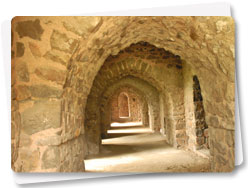 In 1540 a sway of imperial power saw Babur's son Humayun getting defeated by Sher Shah Suri. Sher Shah established another capital city of Delhi. The City, known as Shergarh, was built on the ruins of Dinpanah that Humayun had set up. The remains of Shergarh is what you see today at Purana Qila. Once Humayun came back to power, he completed the construction and proceeded to rule from Shergarh. Firoze Shah completed the mosque of Jamali-Kamali, jamali's Tomb atMehrauli.Shahjahanabad
In 1540 a sway of imperial power saw Babur's son Humayun getting defeated by Sher Shah Suri. Sher Shah established another capital city of Delhi. The City, known as Shergarh, was built on the ruins of Dinpanah that Humayun had set up. The remains of Shergarh is what you see today at Purana Qila. Once Humayun came back to power, he completed the construction and proceeded to rule from Shergarh. Firoze Shah completed the mosque of Jamali-Kamali, jamali's Tomb atMehrauli.Shahjahanabad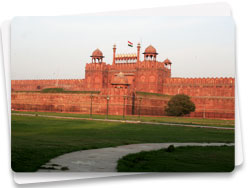 Delhi went into something of an eclipse from the time of Humayun's Delhi to the accession of Shahjahan, the great Mughal builder who in 1648 built Shahjahanabad, the seventh city of Delhi. Shahjahan's Delhi, is today more visible than all the Delhi's built before it. The scale on which he built was also more heroic, as can be seen from the Red Fort and the Jama Masjid. The magnificence of the palace (Red Fort - World Heritage Monument at present) is best described in the famous couplet inscribed in the Diwan-i-Khas:Agar fardos ba rue Zamin ast
Delhi went into something of an eclipse from the time of Humayun's Delhi to the accession of Shahjahan, the great Mughal builder who in 1648 built Shahjahanabad, the seventh city of Delhi. Shahjahan's Delhi, is today more visible than all the Delhi's built before it. The scale on which he built was also more heroic, as can be seen from the Red Fort and the Jama Masjid. The magnificence of the palace (Red Fort - World Heritage Monument at present) is best described in the famous couplet inscribed in the Diwan-i-Khas:Agar fardos ba rue Zamin ast
Hamin ast a hamin ast a hamin ast.
If paradise be on the face of the earth, it is this, even this, it is this
The celebrated poet Mirza Galib, maintained the same fervour and wrote: "If the world is body, Delhi is the soul". There can be no better attributes for a city.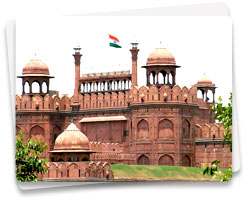 Shahjahanabad was a walled city, and some of its gates and parts of the wall still stand. The romance of the bazaars of Delhi can be experienced at its best in and around Chandni Chowk and its by lanes. Shahjahanabad was secured and enclosed by about ten kilometer long well. Ten gates connected the city with the surrounding region. Lahore gate was the main entrance for the Red Port besides Delhi Gate. The Kashmere Gate, Calcutta Gate, Mori Gate, Kabul Gate, Faresh Khana Gate, Ajmere Gate and the Turkman Gate were the other major links of the city with the highways. A system of Mohallas and Katras was developed to suit the homogenous community structure. Shahjahanabad who furnishes a fine example of secularism which distinguishes it from the bazars of many historic buildings and temples: The Lal Jain Mandir from the time of Shahjahan, Appa Gangadhar Mandir (Gauri Shankar mandir), the only temple built during Marathi dominion, Arya Samaj mandir (Dewan Hall), Baptist Chruch, Gurudwara Sisganj, Sunehri Masjid and west end terminus, the Fateh Puri Masjid. On 9th March, 1739 Nadir Shah defeated Mohammad Shah at Panipat and entered Delhi. He massacred the inhabitants and took over almost the entire wealth Shahjahanbad, accumulated by the Mughals in India. The Peacock throne, priceless stones such as Koh-i-Nur and Darya-i-Nur, fine pieces of art, thousand of horses, camels, and elephants, and numerous books and manuscripts was carried among as booty.New Delhi : Rashtrapati Bhawan
Shahjahanabad was a walled city, and some of its gates and parts of the wall still stand. The romance of the bazaars of Delhi can be experienced at its best in and around Chandni Chowk and its by lanes. Shahjahanabad was secured and enclosed by about ten kilometer long well. Ten gates connected the city with the surrounding region. Lahore gate was the main entrance for the Red Port besides Delhi Gate. The Kashmere Gate, Calcutta Gate, Mori Gate, Kabul Gate, Faresh Khana Gate, Ajmere Gate and the Turkman Gate were the other major links of the city with the highways. A system of Mohallas and Katras was developed to suit the homogenous community structure. Shahjahanabad who furnishes a fine example of secularism which distinguishes it from the bazars of many historic buildings and temples: The Lal Jain Mandir from the time of Shahjahan, Appa Gangadhar Mandir (Gauri Shankar mandir), the only temple built during Marathi dominion, Arya Samaj mandir (Dewan Hall), Baptist Chruch, Gurudwara Sisganj, Sunehri Masjid and west end terminus, the Fateh Puri Masjid. On 9th March, 1739 Nadir Shah defeated Mohammad Shah at Panipat and entered Delhi. He massacred the inhabitants and took over almost the entire wealth Shahjahanbad, accumulated by the Mughals in India. The Peacock throne, priceless stones such as Koh-i-Nur and Darya-i-Nur, fine pieces of art, thousand of horses, camels, and elephants, and numerous books and manuscripts was carried among as booty.New Delhi : Rashtrapati Bhawan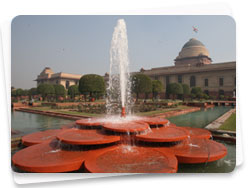 The Mughal dynasty practically came to an end when in 1803, the native rulers defeated by General Lake of East India Company near Patparganj. The East India appointed first resident of Delhi as the 'Protector' of battered Mughal crown. In the early years the British and their troops settled within the walled city around the Red Fort and Kashmere Gate. The city underwent drastic transformations after the war of 1857. One third of the city was razed to rubble in 1858 and the East India Company transferred the rule to the British Crown.On 12th December, 1911, at the historic Delhi Durbar, the George V, the Emperor of the British Empire proclaimed the shifting of the capital of India from Calcutta to Delhi. After announcement of Delhi as the Capital of India, the preparation for the building a new city started with majesty, pomp and show. Thus came up a vary special city, New Delhi, the dream of Edwin Lutyens and Herbert Baker, city planners and architects. Built on the area in and around Raisina Hills, the new city housed among the landmarks, the Rastrapathi Bhawan, (Viceroy's House), the North and South Blocks of the Secretariat, and a Council Chamber which now houses India's Parliament, the 42 meters high memorial arch India Gate, Cannought Place and numerous roads, parks and other structures.
The Mughal dynasty practically came to an end when in 1803, the native rulers defeated by General Lake of East India Company near Patparganj. The East India appointed first resident of Delhi as the 'Protector' of battered Mughal crown. In the early years the British and their troops settled within the walled city around the Red Fort and Kashmere Gate. The city underwent drastic transformations after the war of 1857. One third of the city was razed to rubble in 1858 and the East India Company transferred the rule to the British Crown.On 12th December, 1911, at the historic Delhi Durbar, the George V, the Emperor of the British Empire proclaimed the shifting of the capital of India from Calcutta to Delhi. After announcement of Delhi as the Capital of India, the preparation for the building a new city started with majesty, pomp and show. Thus came up a vary special city, New Delhi, the dream of Edwin Lutyens and Herbert Baker, city planners and architects. Built on the area in and around Raisina Hills, the new city housed among the landmarks, the Rastrapathi Bhawan, (Viceroy's House), the North and South Blocks of the Secretariat, and a Council Chamber which now houses India's Parliament, the 42 meters high memorial arch India Gate, Cannought Place and numerous roads, parks and other structures.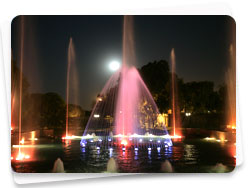 On the site where Delhi stands today, several cities have risen and decayed in the past. Their relics illustrate important phases in the architectural history of the country and are visible symbols of Delhi's glorious past. New Delhi, the capital of India's British rulers, was the eight in the series of city built one after another by successive lines of rulers. The national government, which took over on the attainment of independence in August, 1947, has not built another city. New Delhi, has, however, expanded manifold and is rapidly undergoing transformation. It is from New Delhi that most visitors form their first impression of the city. Much of the New Delhi was built between 1920-1930.After independence, Delhi became the capital of new nation. With the advent of independence, its importance has increased manifold and Delhi has now became the political, economic and culture capital of country. The built - up heritage of Delhi are to be found in groups in the successive cities. Those which should not be missed by a visitors are the Qutub Minar and its adjuncts; Tughlagabad, Humayun's Tomb and shrine of Nizam-ud-Din; Sher Shah's fortS (Purna Qila), Red Fort and the Jama Masjid. To these might be added Kotla Feroz Shah, Safdarjung Tomb, Hauz-Khas, and the Lodi Tombs.Indeed, millennium come and go, Delhi goes on forever. As Pt. Jawharlal Nehru said, "Even the stones of Delhi whisper in our ears of the ages of long ago and the air breathe is full of the dust and fragrance of the past, as also of the fresh and piercing winds of the present.. The traditions of millennia of our history surrounds us at every step and the procession of innumerable generations passed before our eyes."
On the site where Delhi stands today, several cities have risen and decayed in the past. Their relics illustrate important phases in the architectural history of the country and are visible symbols of Delhi's glorious past. New Delhi, the capital of India's British rulers, was the eight in the series of city built one after another by successive lines of rulers. The national government, which took over on the attainment of independence in August, 1947, has not built another city. New Delhi, has, however, expanded manifold and is rapidly undergoing transformation. It is from New Delhi that most visitors form their first impression of the city. Much of the New Delhi was built between 1920-1930.After independence, Delhi became the capital of new nation. With the advent of independence, its importance has increased manifold and Delhi has now became the political, economic and culture capital of country. The built - up heritage of Delhi are to be found in groups in the successive cities. Those which should not be missed by a visitors are the Qutub Minar and its adjuncts; Tughlagabad, Humayun's Tomb and shrine of Nizam-ud-Din; Sher Shah's fortS (Purna Qila), Red Fort and the Jama Masjid. To these might be added Kotla Feroz Shah, Safdarjung Tomb, Hauz-Khas, and the Lodi Tombs.Indeed, millennium come and go, Delhi goes on forever. As Pt. Jawharlal Nehru said, "Even the stones of Delhi whisper in our ears of the ages of long ago and the air breathe is full of the dust and fragrance of the past, as also of the fresh and piercing winds of the present.. The traditions of millennia of our history surrounds us at every step and the procession of innumerable generations passed before our eyes."
No comments:
Post a Comment